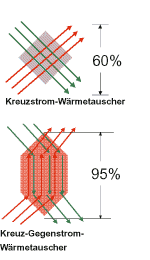

 Types of heat exchangers & heat recovery
Types of heat exchangers & heat recovery

Types of heat exchangers & heat recovery
In general there are two types of heat exchangers: recuperative and regenerative heat exchangers. Among the recuperative heat exchangers are the plate heat exchangers, such as crossflow, counterflow and cross counterflow heat exchangers in which the flows only exchange energy and don’t come into contact with each other. The counterflow allows for heat supply rates that considerably exceed 60% to be reached in the first place. The attained heat supply rate essentially depends on the size of the heat exchanger surfaces. The surface areas of plate heat exchangers can be as large as those of honeycombs or square ducts.
The rotary heat exchanger belongs to the regenerative heat exchangers. The warm air transfers heat and moisture to a storage medium. The latter rotates in a way that the exhaust air is transferred via the storage medium in another position in the opposite direction. Heat and moisture are released. Due to the transferred moisture (high energy content), an increased heat supply rate can be reached. Due to the direct material contact between both flows, there is a risk of transferring odours and pollutants. Therefore, the storage medium must be rinsed in an intermediate range (loss of energy) and the supply air downstream of the heat exchanger must again be cleaned of potential contamination which is stored on the moist storage medium or which occurs there (bacterial contamination) using a good fine filter. The unit hence requires very careful maintenance.
Heat recovery rates and heat supply rates always refer to the sensible, in other words felt, heat without taking into account the energy contained in the humidity due to evaporation heat (latent heat).
Heat recovery rate
The total energy emitted by the exhaust air (incl. latent heat) is divided by the amount of energy that could be emitted if the condensation (latent heat of the exhaust air) wasn’t taken into account. Theoretically heat recovery rates over 100% can be achieved.
Heat supply rate
Instead if the energy emitted by the exhaust air, the energy supplied by the outside air is considered. In this context, the exhaust heat from the fans is also taken into account.
Temperature efficiency
If one assumes that volume flows are balanced and internal leakages are minor, the heat supply rate basically equates the temperature efficiency: Temperature efficiency = (TZu – TAu) / (TAb – TAu)
Equivalent heat supply rate
Equates the heat supply rate which a ventilation system should reach if it had an electrical effectiveness of 5 in terms of the actually reached primary energy savings.
 renovation
renovation
 new buildings
new buildings

